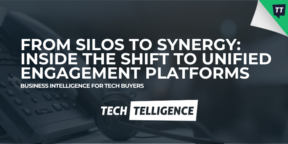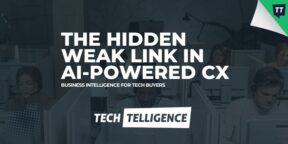Enterprise AI adoption is growing at an incredible rate. Not only do our own studies show that almost half of all companies are using AI to boost productivity, but IDC’s forecasts suggest that spending on AI will reach around $632 billion by 2028.
The really exciting thing? AI isn’t just “automating” tasks – it’s collaborating, reasoning, and even working side-by-side with human professionals through humanoid robots.
Companies aren’t just cutting costs with AI either – they’re using intelligent tools to enhance innovation and creativity, improve decision making, and unlock new opportunities.
So what are the biggest trends transforming the workplace right now?
Enterprise AI Trends: The 8 Hottest Topics
Based on our peer-to-peer research and conversations with major market leaders across the technology space, we can see several key trends taking shape – all of which are having a significant impact on the way businesses operate. Here’s a behind-the-scenes look at some of the hottest topics worth exploring this year.
1. AI Assistants: From Support Tools to Strategic Partners
The days of clunky chatbots working like automated FAQ systems are over. We’re entering an era of AI assistants built with purpose – tools designed to actively understand human beings and adapt dynamically to various workflows. Modern AI assistants and copilots are context-aware, multi-modal, and fully customizable – often through low-code, and no-code platforms.
According to Microsoft, for instance, around 85% of the Fortune 500 are now using Copilot on a regular basis. Elsewhere, hundreds of companies have shared incredible results from the adoption of Google Gemini. Month after month, these assistants become more sophisticated, thanks to the rise of new language models, and flexible features.
Companies are even beginning to invest in more vertical-specific AI solutions, like Microsoft’s “Dragon” Copilot for healthcare, or IBM’s specialist assistants for HR teams. Moving through 2025, AI assistants will continue transforming from helpful tools, into valuable members of every team.
2. Agentic AI: The Next Era of Automation
If AI assistants are the ultimate workplace “copilots”, agentic AI represents the next era of intelligent “autopilot” solutions. Agentic AI systems are truly autonomous – capable of planning, reasoning, and executing multi-step tasks with minimal human input.
These digital colleagues can handle all kinds of complex processes with ease, from planning and implementing a marketing campaign, to walking customers through a personalized onboarding process. Just like modern AI assistants, these solutions are highly customizable.
Agents built with Vertex AI from Google, Microsoft Copilot Studio, or Salesforce Agentforce can connect with your company’s data and applications, follow the rules and guardrails you set, and even collaborate with other bots and human team members.
While the rise of agentic AI will introduce new concerns, forcing companies to carefully consider how much “autonomy” each bot should really have – the productivity and efficiency boosts are sure to be incredible.
3. Humanoid Robots: The Physical Embodiment of AI
We’ve still got a way to go before every office and workplace will have it’s own team of AI-powered humanoid bots working alongside people – but progress is happening quickly. Figure AI, backed by OpenAI and Microsoft, recently partnered with BMW to deploy humanoid robots at their Spartanburg plant. These machines can lift, sort, inspect, and navigate unpredictable environments.
Meanwhile, Sanctuary AI’s Phoenix, a humanoid with dexterous hands and near-human mobility, is being piloted in warehouse picking tasks. Companies like Tesla are already looking at ways to make these bots more accessible to the masses – searching for opportunities to cut development costs.
These machines could make their way into virtually every industry – not just building systems like cars and heavy machinery, but supporting healthcare professionals with patient care, or managing hospitality tasks, admin work, and logistics.
4. AGI and Superintelligence: The Next Frontier
Don’t panic – AI systems aren’t sentient yet – but the next era of artificial intelligence is on the horizon. Google has suggested that “AGI” (Artificial General Intelligence) could emerge as early as 2030 – and OpenAI recently announced new funding for an AGI research program.
AGI could open the door to bots that surpass human intelligence across various tasks. This means they could potentially address challenges that human beings can’t overcome – like finding treatments for complex diseases, or developing new machinery.
Of course, there are concerns too – many enterprises are already developing AGI-readiness task forces, focused on ethical frameworks, policy safeguards and red-teaming strategies.
The fear of a dystopian world ruled by AI systems is real – but the opportunities are great too. AGI could reinvent forecasting, R&D, and innovation pipelines. In finance, it could reimagine risk models. In law, it might automate precedent analysis. The opportunities are endless.
5. Language Models: LLMs, SLMs, and Beyond
LLMs are the secret sauce behind countless enterprise AI adoption trends. From GPT-o1 with its advanced reasoning capabilities, to Claude, and open-source challenges like Mistral and DeepSeek-V3, LLMs are powering assistants, copilots, summarizers, and advisors across industries.
LLMs are even being integrated into the tools we already use every day. Slack integrates GPT-4 to help employees search and summarize past conversations. SAP’s Joule AI uses LLMs to auto-generate insights from operational data. Writer’s Palmyra models are helping Fortune 1000 firms maintain on-brand, secure, and compliant content at scale.
Plus, tech leaders are exploring ways to make these models more efficient and cost effective. Companies like Microsoft and Google are experimenting with Bitnet solutions and small language models that don’t rely on expensive GPUs or specialist hardware. This could power a rapid surge in adoption among smaller businesses and startups.
6. Evolving AI Governance and Security
Exciting AI tech is useless without trust – and when it comes to AI, the focus on governance is huge. Enterprises are scrambling to set up AI risk frameworks, ethical review boards, and compliance tools. Why? Because one hallucinated legal clause or rogue AI decision can cost millions.
Currently a lack of clear policies, frameworks and security standards remains one of the biggest barriers to scaling enterprise AI adoption. Meanwhile, regulatory bodies worldwide are proactively shaping future rules and frameworks, from the EU’s AI Act and U.S. Executive Order on AI safety.
Fortunately, leaders in the AI space are innovating fast, implementing new “explainability” features to fight back against black box AI, and empowering companies to set their own guardrails for safety. As AI becomes more powerful, and more capable of replicating human tasks – including making decisions – demand for end-to-end governance will continue to grow.
7. AI Democratization: Making AI Accessible
AI isn’t just for trillion-dollar enterprises anymore. Thanks to smaller language models, like Google’s Gemma, and plug-and-play platforms, smaller companies are gaining access too. Companies can now find AI baked into virtually every contact center, collaboration platform and project management app.
Plus, most of the leaders experimenting with AI, as mentioned above, offer companies access to low-code and no-code tools that allow them to customize agents without technical expertise.
We’re even seeing the rise of dedicated AI consultants and specialists that can work alongside companies to help them identify opportunities for AI development and implement new tools. Plus, partners are offering access to new services, like data preparation for AI adoption, AI policy consultation packages and more.
8. Compound AI Systems: Orchestrating Components
No single AI model can accomplish everything on its own – at least not yet. Even agentic AI solutions often depend on access to various models and tools. Compound AI systems build on the concept of agentic AI, aligning multiple LLMs, vision models, APIs, and decision engines.
Just like agentic AI tools, these solutions are goal oriented – but they’re far more flexible, capable of drawing on numerous interacting components to accomplish various tasks.
Imagine an AI assistant that reads your financials (via OCR), summarizes risks (via GPT), and updates your CRM (via Zapier). That’s the promise of compound AI systems – already being developed by companies like LangChain, CrewAI, and many others.
Embracing the Enterprise AI Revolution
We’re not just theorizing about the future of AI in the Enterprise anymore, we’re in an active stage of experimentation, exploring countless new avenues that seemed impossible only a few years ago.
AI has moved from labs to laptops, from novelty to necessity. Whether you’re running a Fortune 500 or a local coffee chain, the message is clear: adopt or fall behind.
Yes, there will be risks to overcome as we move forward, and challenges to address – but demand for AI solutions isn’t going to slow down. Want to make sure you stay one step ahead of each emerging trend? Check out our latest reports for insights straight from the biggest technology leaders.









